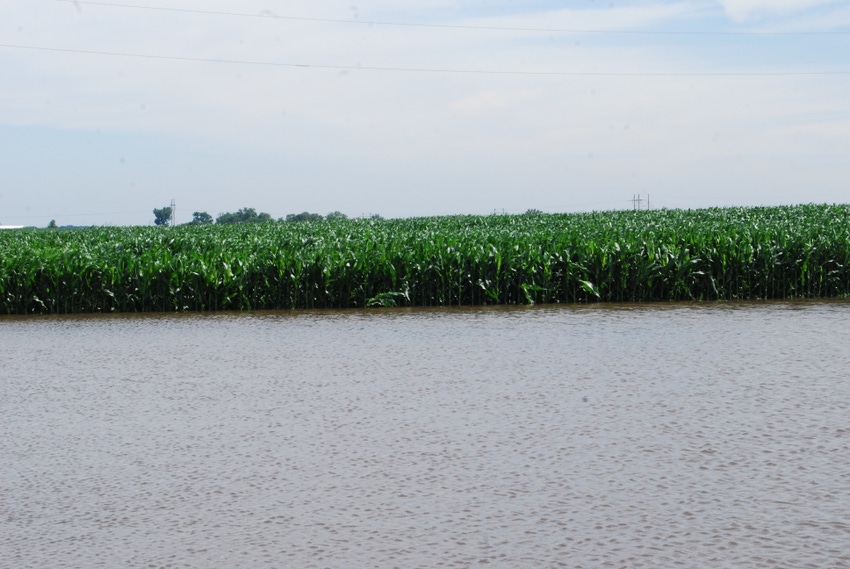
A fast and furious rainstorm June 30 dumped 5 to 10 inches of rain in central Iowa in a couple of hours. Overflowing creeks and rivers turned low-lying field areas into lakes. Strong winds caused green-snap damage to corn in some locations. Some corn and soybeans were hit by hail. Farmers affected now face tough decisions.
What’s the first step you should take if you have crop damage?
“Contact your crop insurance agent now, if you haven’t already,” advises Steve Johnson, Iowa State University Extension farm management specialist. “It’s important you document there is a loss due to natural peril. Don’t destroy a damaged crop. Don’t go in and start chopping corn for silage, if you have that corn insured.”
Most farmers in Iowa have approximately a $400 per acre crop insurance revenue guarantee for soybeans and close to $600 for corn. Don’t destroy the crop and then not be able to collect the insurance, cautions Johnson. Not until the adjuster approves or releases a field should you try to harvest or destroy any of that crop.
Questions farmers are asking
Farmers should have kept accurate records of planting dates this spring, Johnson notes. Write down the dates you planted the crop, number of acres and the reference — that’s the farm name or identification number. "Good planting records are important for crop insurance coverage purposes and for completing the annual USDA Farm Service Agency acreage report that must be filed prior to July 15," he says.
Johnson provides the following answers to questions farmers are currently asking.
What should a producer do if his/her planted crops are affected by flooding, wind or hail?
Notify your crop insurance agent or insurance carrier within 72 hours of the loss. The agent’s company will assign a crop insurance adjuster to work directly with the insured farmer.
Can I destroy the damaged crop and prepare to replant?
It’s important that you do not destroy a field that has crop damage until a crop insurance adjuster has approved and released the field for other cropping or potential tillage practices. Listen carefully and document the adjuster’s recommendations. Work with your crop insurance agent regarding potential indemnity payments and continue “good farming practices” as required to maintain crop insurance coverage.
What if the field remains underwater for an extended time?
If your field is underwater for an extended period, let your agent know. The agent can help file a notice of damage and have the insurance company take a closer look.
Isn't there a 20-20 rule for crop insurance coverage?
Yes, to qualify for an indemnity payment under the replanted, delayed or prevented planting provisions, a minimum area of 20 acres or 20% of the insured unit, whichever is smaller, must be affected.
A unit could be a field or a farm — if you elected an optional whole farm or basic unit in your policy. An enterprise unit could also have been elected, which reflects all the corn acres or all the soybean acres grouped together in the county.
I chose enterprise units to save on premium cost. Can I now change to basic or optional units because flooding has damaged my planted crop acreage on a few fields?
Because the unit structure impacts the premium cost, and in the case of enterprise units, also the premium subsidy, the policyholder's decision to elect enterprise units is made no later than the sales closing date to reflect the binding contractual agreement between the two parties on or before March 15.
In some cases, says Johnson, it may be necessary to wait until actual harvest of the affected crop in the fall to determine damage. Some yield loss estimates can be made early if the field is released by the crop insurance adjuster and the crop is destroyed. However, many farmers are using enterprise units to insure the crop. Thus, they’ve combined all their cornfields together in the county for crop insurance purposes. They aren’t insuring their crop by section.
If you have enterprise units, you have to wait until you get in to harvest the crop in the fall, Johnson says. Then you turn in your production evidence. You’ll have to measure all the production, times the harvest price and subtract that answer from your crop insurance revenue guarantee.
“So, it’s likely there isn’t going to be any crop insurance payment to come to you soon, unless you have hail or green-snap coverage in addition to the federal crop insurance policy,” Johnson says. “Again, it’s important you take pictures of damage and listen carefully to the adjuster. You may need to call your crop insurance agent back in a week and report that ‘Yes, that field is still underwater.’”
ISU’s Disaster Recovery website is now updated with new resource and farm management information related to flooding, high winds and hail etc.
About the Author(s)
You May Also Like




